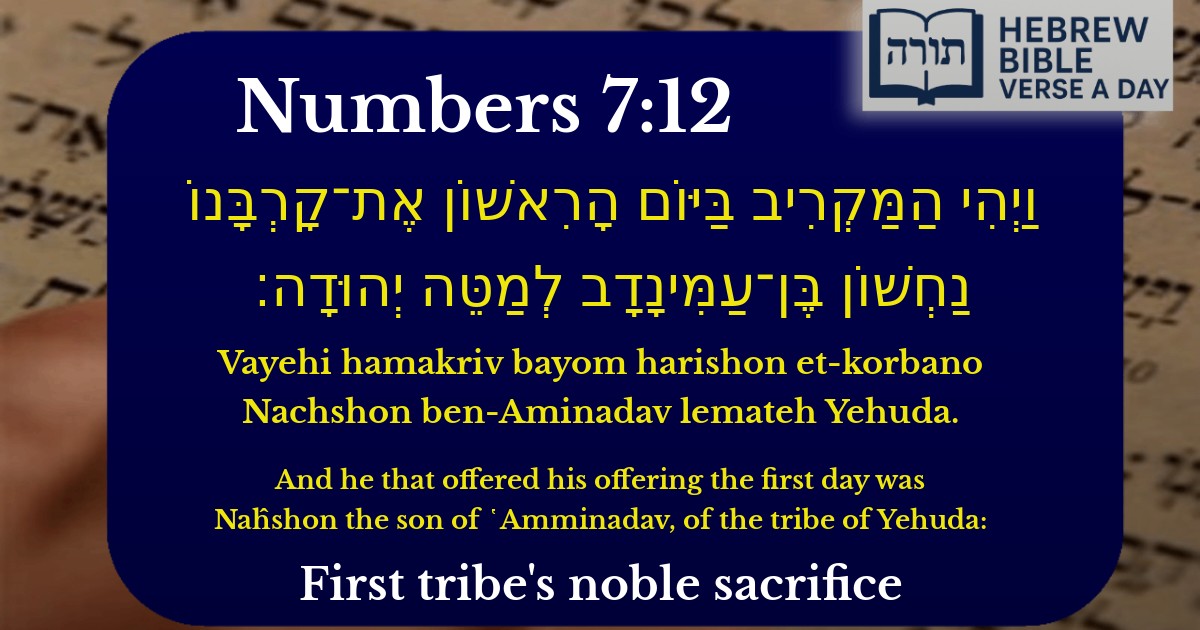Join Our Newsletter To Be Informed When New Videos Are Posted
Join the thousands of fellow Studends who rely on our videos to learn how to read the bible in Hebrew for free!
Hebrew Text
וַיְהִי הַמַּקְרִיב בַּיּוֹם הָרִאשׁוֹן אֶת־קָרְבָּנוֹ נַחְשׁוֹן בֶּן־עַמִּינָדָב לְמַטֵּה יְהוּדָה׃
English Translation
And he that offered his offering the first day was Naĥshon the son of ῾Amminadav, of the tribe of Yehuda:
Transliteration
Vayehi hamakriv bayom harishon et-korbano Nachshon ben-Aminadav lemateh Yehuda.
Hebrew Leining Text
וַיְהִ֗י הַמַּקְרִ֛יב בַּיּ֥וֹם הָרִאשׁ֖וֹן אֶת־קׇרְבָּנ֑וֹ נַחְשׁ֥וֹן בֶּן־עַמִּינָדָ֖ב לְמַטֵּ֥ה יְהוּדָֽה׃
Parasha Commentary
📚 Talmud Citations
This verse is quoted in the Talmud.
📖 Sotah 37a
The verse is referenced in a discussion about the order of the tribal leaders' offerings during the dedication of the Tabernacle, highlighting Nachshon's role as the first to bring an offering.
📖 Bava Batra 120a
Mentioned in the context of discussing the merits and precedence of the tribe of Judah, with Nachshon's offering cited as an example of their leadership.


The Significance of Nachshon ben Aminadav
The verse (Bamidbar 7:12) highlights Nachshon ben Aminadav as the first tribal leader to bring an offering during the dedication of the Mishkan. Rashi explains that Yehuda merited this honor because they were the first tribe to step forward at the splitting of the Red Sea (Shemot 14:22), demonstrating unwavering faith in Hashem. Nachshon, as the prince of Yehuda, exemplified this trait of bold leadership and trust in divine salvation.
Symbolism of the Order of Offerings
The Midrash (Bamidbar Rabbah 13:7) teaches that the sequence of tribal offerings followed the order of their encampment around the Mishkan, with Yehuda leading as the eastern camp. Ramban adds that this arrangement reflects the divine wisdom in structuring the tribes, with Yehuda representing kingship (Malchut) and thus given precedence. The Sforno emphasizes that Nachshon's offering set a model for all subsequent leaders—each brought identical gifts, yet each was unique in its spiritual intent.
Nachshon’s Legacy of Courage
The Talmud (Sotah 37a) recounts that Nachshon was the first to jump into the Red Sea before it miraculously split, embodying the principle of hishtadlut (human effort) paired with emunah. This act cemented his role as a paradigm of proactive faith, which carried into his leadership during the Mishkan’s inauguration. The Kli Yakar notes that his name "Nachshon" (from nachash, serpent) alludes to overcoming the serpentine cunning of the yetzer hara through righteous action.
The Tribal Role in Divine Service